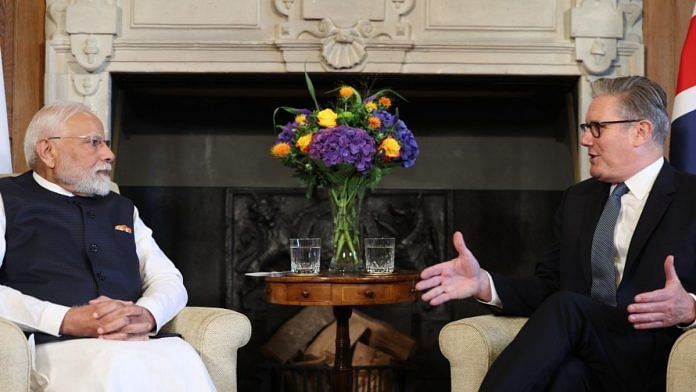New Delhi: As the prime minister of the United Kingdom, Keir Starmer, flies into Mumbai Wednesday to meet with business leaders and hold bilateral talks with his Indian counterpart Narendra Modi, the key focus will be on deepening economic and defence ties between the two countries.
According to sources in the know, while India and UK have signed a Free Trade Agreement, its official ratification in London is likely to take place by March next year as British law says that such agreements must go through the scrutiny of their parliament.
Meanwhile, UK’s Carrier Strike Group (CSG), led by HMS Prince of Wales aircraft carrier, is currently undertaking Exercise Konkan with the Indian Navy in the Western Indian Ocean. Whilst the exercise has been biennial since 2004, it marks the first time in history that a British and Indian Carrier Strike Group are conducting a maritime exercise together.
Sources said that a key area of focus for the UK is defence ties, especially from a joint design and production point of view.
One of the main programmes that the UK is looking at is the one for co-development and co-production of a new fighter engine that will power the futuristic Advanced Medium Combat Aircraft (AMCA) with a new 120 kN engine. However, Defence Minister Rajnath Singh had, in August, announced that India has decided to go with French firm Safran for the engine manufacturing.
But the UK remains hopeful because neither it nor British firm Rolls-Royce has heard anything officially. UK’s contention is that Rolls-Royce is the only company that has designed new engines in the last two decades and is vying for the project, leaving American firms GE, and Pratt and Whitney, aside.
“Rolls-Royce is part of the GCAP (Global Combat Air programme) under which a sixth-generation fighter is being created in collaboration by UK, Italy and Japan. Imagine the scale of work that goes into this, which will come handy in the new engine development for the AMCA,” a source said.
Sources further underlined that the UK has said it prefers to promise what it can deliver, and eventually over deliver, rather than making tall promises, but not delivering in time—a dig at Safran.
India had previously tried to partner with France on the Kaveri engine programme, but it could never take off fully.
The new engine, whose development is set to be completed in 10 years followed by production, will power the second tranche of the AMCA. The first set of AMCA will be equipped with the GE 414 engines. They are to be developed in India under Indian IPR, with the foreign firm transferring 100 percent of the technology to the Defence Reseach and Development Organisation (DRDO), including crystal blade technology.
“The UK government fully backs this initiative, and remains committed to this co-development project. The UK has the history and the ability to design and deliver engines. Rolls-Royce has already expanded its operations in India, and Indian engineers are working on their engine programmes already,” a second source said.
Rolls-Royce already powers some of the Indian Air Force aircraft, like the Jaguars, Hawks and the C-130Js. It has also tied up with Hindustan Aeronautics Limited (HAL) to offer MT30—the most powerful marine gas turbine used by a number of navies, including those of Japan, the UK and South Korea, among others. It also powers several Indian ships and submarines with its marine gas turbine technology through the MTU brand.
Sources explained that the UK has been in continuous talks with Indian authorities since the Request for Information was first issued by the Gas Turbine Research Establishment (GTRE), a lab under the DRDO, in 2013. No Request for Proposal (RFP) has been issued since, even though both companies are in touch with GTRE.
Incidentally, joint production and co-development of fighter jets and next-generation jet engine technology is part of the two countries’ Comprehensive Strategic Partnership announced in 2021.
India and the UK had, in July this year, announced a defence industrial roadmap as part of the broader Vision 2035 partnership, which focused on “deepening collaboration in advanced technologies and complex weapons through programmes like Electric Propulsion Capability Partnership (EPCP) & Jet Engine Advanced Core Technologies (JEACT) Innovation and co-development are key priorities”.
The UK-India defence partnership is set to go bigger. A detailed 🧵 on what the two countries are setting to work on in the coming decade… pic.twitter.com/NH6CS5jng0
— UK Defence in India🇬🇧🇮🇳 (@UKDefenceIndia) July 30, 2025
(Edited by Mannat Chugh)






